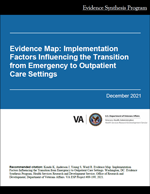
Prepared by:
Evidence Synthesis Program (ESP) Coordinating Center
Portland VA Health Care System
Portland, OR
Mark Helfand, MD, MPH, MS, Director
Recommended Citation:
Kondo K, Anderson J, Young S, Ward R. Evidence Map: Implementation Factors Influencing the Transition from Emergency to Outpatient Care Settings. Washington, DC: Evidence Synthesis Program, Health Services Research and Development Service, Office of Research and Development, Department of Veterans Affairs. VA ESP Project #09-199; 2021.
Download PDF: Evidence Map, Supplemental Materials
Twenty-four studies (6 of VHA settings) reported outcomes related to utilization, intermediate or patient outcomes. All but 1 study reported that interventions were similar-to, or more effective than comparators. Barriers of transition to VHA settings related to identifying Veterans in community settings and the VHA formulary. Reported implementation-related barriers in VHA settings included concerns about workflow, differences in stakeholder priorities, and time. In other settings workflow was also a concern, as were time and inefficiency.
Transitions between different health care settings present a range of challenges to the management and continuity of care, such as electronic health record (EHR) interoperability and miscommunication between providers. Patients transitioning from the ED to outpatient care across health care settings are especially vulnerable, as they are likely recovering from injuries or acute illness and being treated by a new provider with limited access to their medical history.
Twenty-four studies (6 VHA) reported outcomes related to utilization, intermediate or patient outcomes. All but 1 study reported that interventions were similar-to, or more effective than comparators. Barriers of transition to VHA settings related to identifying Veterans in community settings and the VHA formulary. Reported implementation-related barriers in VHA settings included concerns about workflow, differences in stakeholder priorities, and time. In other settings workflow was also a concern, as were time and inefficiency. Common barriers across all ED to outpatient transitions included difficulty scheduling follow-up appointments, rural residence, and lack of transportation, childcare, and insurance. Future studies of interventions to mitigate frequent ED use are needed, as are the exploration of patient outcomes across populations. Future systematic reviews should include observational and quality improvement studies. In addition, a systematic review augmented by VHA stakeholder interviews investigating common themes from qualitative research on this topic may provide important insight for implementation.